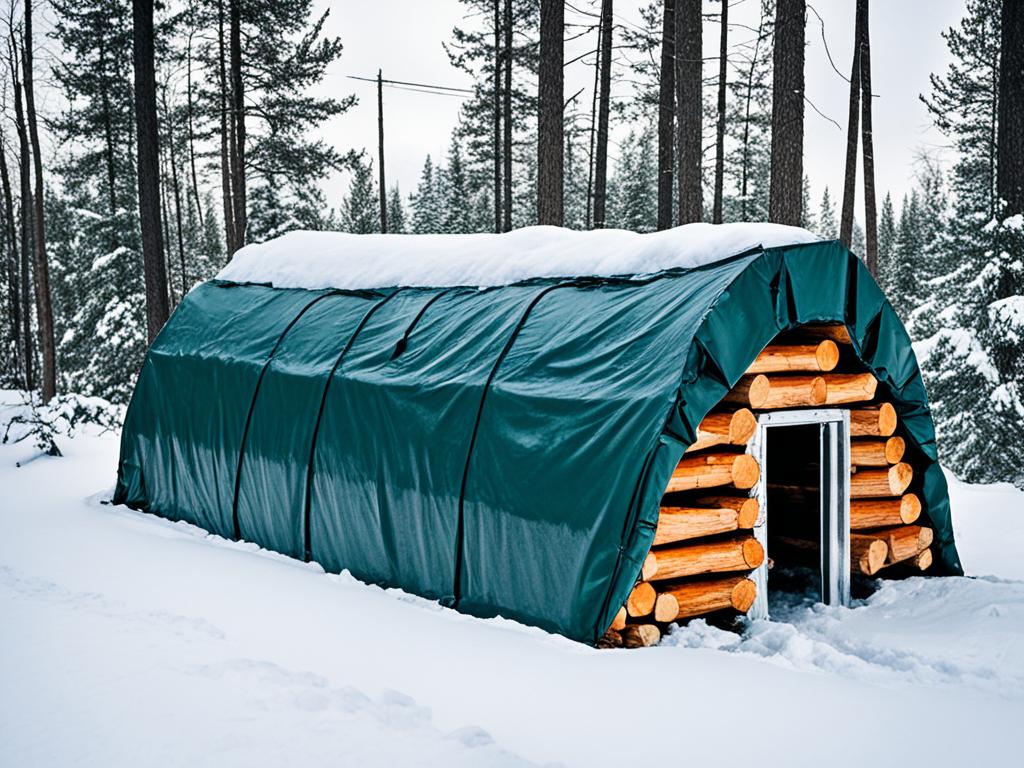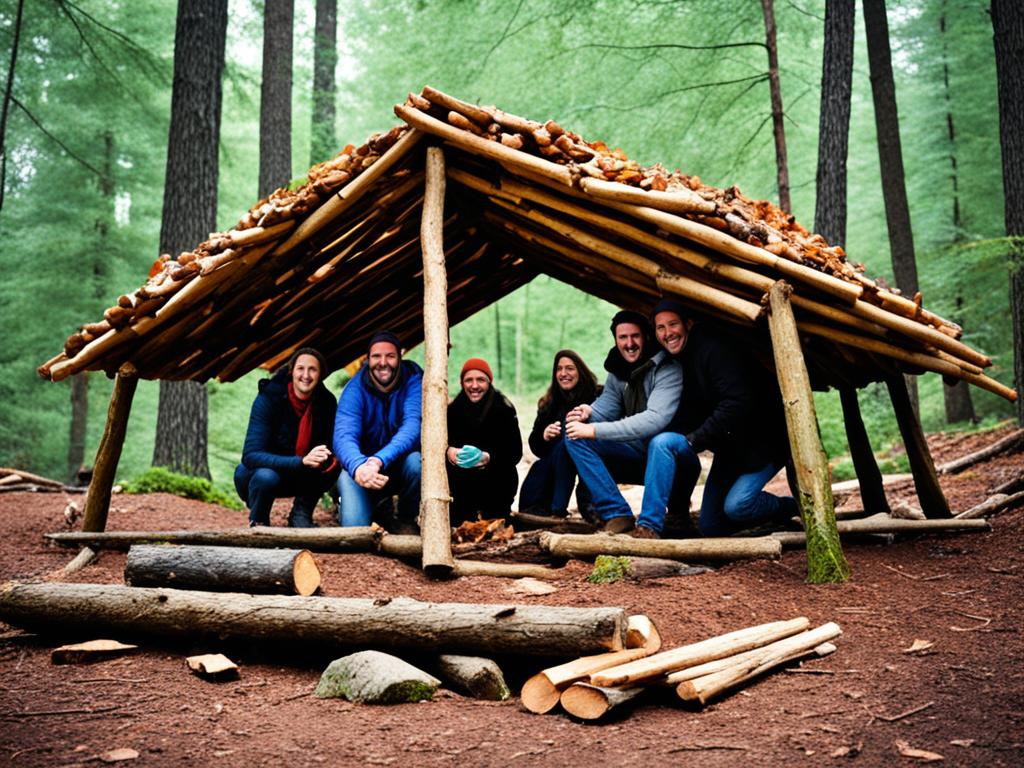When skies get dark and winds start howling, where can you find safety? I started exploring survival shelters out of curiosity and the need to know. These shelters are crucial for staying safe. They are not just simple structures. They are symbols of hope and strength during hard times. I’ve learned the real benefits of survival shelters. They offer peace of mind in our uncertain world.
Key Takeaways
- Understanding the true essence of survival shelters and why they’re more than mere structures.
- Insight into the life-saving potential and psychological comfort survival shelters offer.
- Recognizing the fundamental role of survival shelters in emergency preparedness and disaster readiness.
- Exploring how these sanctuaries serve as pillars of strength in both expected and unforeseen circumstances.
- Appreciating the myriad of benefits that come from investing in a secure and reliable survival shelter.
Understanding the Importance of Survival Shelters
Emergency preparedness is more than just making a plan. It includes having a strong, reliable place to carry out that plan. Survival shelters are key in this, offering a safe spot in tough times. In the next sections, I’ll explain what makes up a survival shelter, their importance in disasters, and how they affect our minds.
Defining Survival Shelters in Emergency Preparedness
Survival shelters mean a lot of different safe spots, from natural hideouts to built structures. Their purpose is clear: to keep people safe during disasters. The types of emergency shelters show how well we understand different threats we might face.
How Survival Shelters Can Save Lives During Disasters
In disasters, having a quick access to a safe shelter can mean the difference between life and death. Whether it’s a quick-setup tent or a strong bunker, these shelters save lives. They’re not just walls against storms; they’re places to manage help, coordinate efforts, and keep spirits up.
The Psychological Impact of Having a Safe Place
Having a safe place does more than just protect us physically; it helps our minds too. Knowing there is a safe place lowers stress and fear in emergencies. This calmness aids in making smart choices and strengthens our readiness for disasters. Indeed, the certainty of having a shelter changes fear into preparation.
Looking deeper into survival shelters, it’s clear they’re woven into emergency preparedness. This piece sheds light on the vital role of these shelters. It highlights not just their physical benefits, but also the mental peace and improved outcomes they bring to those who might need them one day.
Exploring the Different Types of Emergency Shelters
When thinking about emergency shelters, knowing the different types is key. Each kind is made for certain situations. This includes rapid evacuations to surviving harsh conditions for a long time.
Temporary vs Permanent Shelter Solutions
Temporary shelters are quick to set up when disaster strikes. They are tents and quick-to-assemble structures for fast relief. But, permanent shelters are built to last. They stand up to tough conditions. Examples include sturdy cabins and underground bunkers.
Natural Shelters: Using What the Environment Offers
In wild places, natural shelters use the surroundings for protection. Things like overhangs and caves or simple leaf and branch setups can keep you safe for a bit.
Man-Made Structures: From Tents to Bunkers
Man-made shelters vary widely. They go from basic tents to secure bunkers. They’re made with protection in mind, ready for many dangers.
| Type of Shelter | Characteristics | Duration | Suitable For |
|---|---|---|---|
| Tents | Lightweight, portable, quick setup | Short-term | Immediate relief and mobility |
| Natural Shelters | Use of environmental features, Zero cost | Temporary | Wilderness survival, Minimal impact |
| Underground Bunkers | Reinforced, Long-lasting, Equipped for sustainability | Long-term | Extended disasters, High-security needs |
| Reinforced Cabins | Sturdy, Customisable, Self-sufficient options | Medium to long-term | Off-grid living, Harsh climates |
Learning about shelters has shown me the importance of good preparation. Choosing the right emergency shelter means matching it to the possible dangers and what people or groups need.
Evaluating the Best Survival Shelter Features
In my quest to find the top survival shelter traits, I discovered vital features. These features are must-haves because they protect us during unexpected disasters. They offer significant benefits and can be life-saving.
When safety is a priority, it’s vital to have a shelter that can withstand the harshest conditions without faltering.
Now, let’s talk about the critical features a top-notch survival shelter needs. I’ll break down each one for you. This will show how they make a shelter effective in emergencies. Here’s what to look for:
- Durability: Robust construction to endure extreme weather and environmental conditions.
- Waterproofing: Ability to prevent water infiltration, preserving the internal environment from moisture and floods.
- Insulation: High-quality insulation is key to maintaining a stable temperature inside the shelter, be it blistering heat or freezing cold.
- Energy Efficiency: The use of renewable energy sources or well-designed systems to minimize energy consumption.
- Food and Water Reserves: Adequate storage for long-term supplies of non-perishable food and potable water.
- Air Filtration: Advanced air filtration to ensure a breathable atmosphere, free from contaminants and gases.
- Security: Features that protect against unauthorized entry and offer peace of mind.
To help you understand better, here’s a table showing each feature and its benefit:
| Feature | Benefit |
|---|---|
| Durability | Ensures long-term structural integrity under stress |
| Waterproofing | Keeps occupants dry and equipment functioning |
| Insulation | Maintains habitable temperatures, conserving energy |
| Energy Efficiency | Extends the shelter’s operation, reduces reliance on external resources |
| Food and Water Reserves | Supports self-sufficiency, reducing need for risky excursions |
| Air Filtration | Promotes healthful living conditions, crucial in biological/chemical events |
| Security | Deters intruders, protects against wildlife and looters |
Picking the right spot and including these features makes a dependable shelter. It lowers risks and boosts the benefits of a survival shelter. Most importantly, it gives you confidence in crisis times. It ensures that, amid outside chaos, your shelter stays safe.
To sum up, choosing the best survival shelter features goes beyond just checking off a list. It’s about understanding and applying the elements that ensure safety, comfort, and durability for you and your loved ones in emergencies.
Advantages of Shelters in Harsh Weather Conditions
Thinking about the advantages of shelters brings to mind their key role in harsh weather survival. These shelters are more than just backup plans. They are sanctuaries from extreme weather’s harsh effects. Whether facing scorching heat or freezing blizzards, shelters protect us from nature at its fiercest.

Shelters have many benefits, like blocking strong winds and keeping inside temperatures steady. They also provide a safe and dry area. Features such as insulated walls and sturdy builds make shelters effective. They ensure everyone inside stays safe and comfy, no matter the weather outside.
| Weather Condition | Shelter Advantage |
|---|---|
| Extreme Cold | Insulation and heating systems maintain a livable temperature |
| Heavy Rainfall | Waterproof materials and elevation prevent flooding |
| High Winds | Aerodynamic design and sturdy construction resist wind damage |
| Intense Heat | Reflective surfaces and ventilation reduce indoor heat |
The true advantages of shelters in harsh weather survival go beyond just surviving. They create a controllable living space. This not only keeps us physically safe but also supports mental strength. Knowing you’re protected is invaluable during nature’s most challenging times.
„Survival Shelters and Their Benefits“: Ensuring You’re Disaster Ready
When the sky gets dark and the wind picks up, being ready for a disaster means a lot. Survival shelters become more than an idea; they are safe spots. They do more than just keep you safe—they help you feel secure. I’ve looked into how survival shelters help in many ways. They’re very important for keeping safe and feeling ready for the unexpected.
The Role of Shelters in Sustaining Life and Health
The main job of survival shelters is to keep us alive. In disasters, they protect us from the weather, giving us a safe spot. They offer shelter, warmth, and a way to stay clean. While they are built sturdy, they also prevent sickness from the cold or wet. So, the design of a survival shelter is key. It helps us not just get through a disaster but stay healthy too.
Emotional Security: The Comfort of Being Prepared
Knowing you’re ready for a disaster really helps ease the mind. It’s hard to measure, but the feeling of safety is huge. Being sure of your safe place and having what you need helps a lot. It keeps you calm when managing a disaster.
Looking into survival shelters shows they help in seen and unseen ways. They offer solid protection and boost our spirits. They remind us that being ready is about more than a list. It’s about looking after our minds and bodies.
Key Components in Effective Emergency Shelter Planning
Thinking about emergency preparedness, creating a good shelter plan is key to staying safe and strong. The planning process might seem tough. Yet, breaking it down into key parts makes it easier and helps cover everything important.
First, making a safety checklist is crucial. It covers the most urgent needs in an emergency. This includes:
- Structural integrity of the shelter
- Accessibility for all individuals, including those with disabilities
- Adequate space for the anticipated number of occupants
Next, I think about the essential resources needed to keep people alive in a shelter. This is during unexpected emergencies.
- Clean water supplies
- Non-perishable food stocks
- First aid kits and necessary medications
After covering the basics, I focus on comfort and keeping spirits up. This means making sure the shelter has:
- Bedding and clothing suitable for different climates
- Activities or materials for mental stimulation and comfort
- Strategies to maintain hygiene and sanitation
Preparedness means safeguarding every part of life. It’s about knowing we can get through tough times and come out stronger.
Last, revisiting and updating the effective shelter planning regularly is vital. It’s not just about creating a plan. It’s about making sure it adapts to new challenges, advancements, and personal needs. This involves:
- Regularly checking and replenishing supplies
- Testing structural durability against potential threats
- Conducting emergency drills and training with others who share the shelter

Preparing in advance, careful stockpiling, and staying alert are the main pillars of emergency preparedness. By focusing on these areas, I make sure I’m always ready. This way, both my safety and that of others is well-planned, aiming for survival and comfort.
Preparation and Maintenance of Your Survival Shelter
Getting your survival shelter ready is more than a one-time effort. It requires continuous work. Effective shelter preparation and maintenance ensure your safe spot stays ready and functional. Here’s why keeping your shelter in great shape and doing emergency drills are key to being prepared.
Regular Checks and Upkeep of Shelter Supplies
The calm before the storm is the best time to get ready. It’s important to regularly check your survival shelter. Make sure everything is undamaged and your supplies are fresh and plentiful. For your peace of mind, here are some top shelter maintenance tips:
- Inspect the shelter structure bi-annually for any signs of wear or damage
- Check supplies monthly, keeping an eye out for expiration dates and potential spoilage
- Rotate food and water supplies regularly to maintain freshness
- Test all electronic equipment and backup power sources to confirm they are functioning properly
Training and Drills: Familiarize Yourself with Your Shelter
Knowing every corner of your shelter can save lives. When panic hits, your muscle memory can help you more than thinking can. That’s why emergency drills are vital. Regularly practicing how to use your shelter means you’ll be ready for any emergency. This readiness can save precious seconds:
| Frequency of Drills | Key Focus Areas | Duration |
|---|---|---|
| Quarterly | Evacuation to Shelter | 15-20 minutes |
| Bi-annually | Full Shelter Lockdown Procedure | 30 minutes |
| Annually | Emergency Supply Rationing | 10-15 minutes |
By fully committing to shelter preparation and maintenance and doing regular emergency drills, you do more than protect a place. You are keeping people safe. The state of your survival shelter reflects the effort you put into it.
Real-Life Stories: How Survival Shelters Have Made a Difference
Exploring survival shelter stories shows their true value. They share real-life survival accounts that are both shocking and uplifting. Seeing survival shelters in real situations shows us they truly save lives and give hope during tough times.
Many real-life survival accounts talk about surviving natural disasters. Here, the strength and quick setup of survival shelters are crucial. They offer safety and make a big difference in people’s lives.
“In the face of calamity, our survival shelter stood as a bulwark against the chaos of the world outside, solidifying itself not just as a structure, but as a beacon of hope for our community.”
These accounts reveal how people find safety in planned or quickly-made shelters. Having a survival shelter ready is key in these critical moments.
Below, a table shows different success stories with survival shelters. It highlights the key things that led to their effective use.
| Incident | Location | Shelter Type | Outcome |
|---|---|---|---|
| Tornado Strike | Oklahoma, USA | Underground Storm Shelter | Family of six survived unharmed |
| Forest Fire | California, USA | Fire-resistant Earthbag Dome | Home and occupants remained protected |
| Hurricane | Florida, USA | Reinforced Concrete Safe Room | Community used it as a haven for 48 hours |
| Earthquake | Haiti | Temporary Relief Shelter | Provided emergency shelter for displaced families |
| Flash Flooding | Louisiana, USA | Elevated Flood-proof Home | Residence remained dry while area flooded |
These survival shelter stories aren’t just incredible stories. They show how human creativity and the desire to survive can truly make a difference. They highlight the importance of being prepared and how it can save lives.
Innovations in Shelter Design and Materials
In recent years, we’ve seen big changes in shelter innovations. These changes come from the need to face new environmental challenges and help people in need. As someone who follows the latest trends in architecture and emergency readiness, I’ve noticed these advances are changing how we create and build shelters.
Advancements in Portable and Modular Shelters
The push for shelters that are easy to move and put together is a big change. Thanks to new materials and thinking, we now have shelters that are quick to set up, light, and flexible for different places and weather. Portable shelters are very important for quick help after natural disasters. On the other hand, modular shelters can grow quickly, helping more people during emergencies or when more people suddenly need a place to stay.
Sustainability and Self-Sufficiency in Shelter Construction
Making shelters last longer and with less impact on the environment is key today. Builders use clean energy, green materials, and ways to collect rainwater. By doing this, shelters can do more with less harm to the earth. They also don’t depend as much on outside help. This means more safety and freedom for people living in them, especially in hard times.
This change in how we build shelters is starting a new chapter in architecture. With shelter innovations, we’re not just protecting people today. We’re also building a future where shelters help our planet and make us more independent.
Conclusion
Looking back, we see that survival shelters vary widely in type and purpose. They range from simple natural spots to complex bunkers. These shelters are key for emergency readiness. They offer not only safety but also comfort when danger looms.
In facing disasters or sudden emergencies, knowing about survival shelters is vital. Final thoughts on survival shelters highlight their importance as a safety net. This is ever more important in today’s uncertain times. I encourage learning and innovation in shelter development. This will help them better serve our needs and keep us safe.
Thanks to advances in technology and design, we can now improve what shelters provide. Here’s a breakdown of important features for choosing or building a survival shelter:
| Feature | Description | Benefits |
|---|---|---|
| Robust Construction | Durability to withstand various hazards | Longevity and safety in diverse conditions |
| Location | Strategically chosen for accessibility and safety | Reduces risk and ensures swift occupation when needed |
| Supply Stockpile | Adequately equipped with essentials for survival | Self-sufficiency during extended periods of use |
| Comfort Considerations | Inclusion of facilities for rest and mental well-being | Supports overall health, morale, and long-term occupancy |
In summary, the perfect survival shelter varies by need. However, including key features makes any shelter stronger. I hope these final thoughts on survival shelters spark interest. May they inspire us to better protect ourselves and those we care about in emergencies.
[Reserved for SEO Optimization Post-Conclusion]
As we finish our look into survival shelters, it’s key to add what we’ve learned to your emergency plans. Knowing about the different shelters, what they offer, and how to plan them means you’re ready to keep safe when needed. This knowledge helps you create a strong place to stay safe during disasters.
Being ready means more than just making a shelter. It’s about having a mindset of being aware, ready, and able to adapt. We talked about how to pick the best shelter and how to keep it up. Each point is vital in making a solid plan to face disasters.
Getting ready for disasters is a continuous journey. Keep coming back to this info, update your emergency kit, and keep up with new tips. By constantly improving your preparedness, you’re setting up the strongest defense: a well-thought-out survival shelter.

